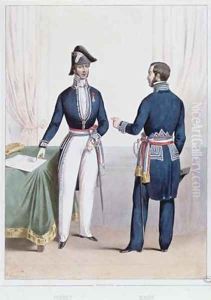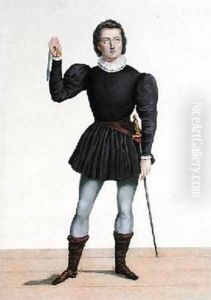Lacauchie, Alexandre Paintings
Alexandre Lacauchie was a French lithographer and watercolorist born in 1814. Though not as widely recognized as some of his contemporaries, Lacauchie made significant contributions to the world of 19th-century French art, particularly in the realm of lithography, a printing process that was gaining popularity during his lifetime. His works often reflected the social and cultural milieu of his era, capturing the vibrancy and complexities of 19th-century France.
Lacauchie specialized in creating portraits and theatrical scenes, often focusing on the celebrities and notable figures of his day. This was a period marked by a burgeoning public interest in the personal lives of public figures, a trend to which Lacauchie's work catered effectively. His lithographs served not only as works of art but also as mediums for the wider public to engage with the likenesses and personas of these individuals.
Throughout his career, Lacauchie collaborated with various publishers and theatres, contributing to the popularization of lithography as an art form. His ability to capture the essence and character of his subjects with precision and sensitivity garnered him a respected place among the lithographers of his time. Despite the prominence of other artists in this medium, such as Honoré Daumier and Théodore Géricault, Lacauchie maintained a distinct style characterized by meticulous detail and a keen sense for the dramatic.
Lacauchie's contribution to the arts extends beyond his individual works. By capturing the cultural icons of his time, he contributed to the historical documentation of 19th-century society, providing future generations with a window into the past. His works are preserved in various collections and museums, offering insights into the evolving techniques of lithography and the social currents of his time.
Alexandre Lacauchie passed away in 1881, leaving behind a legacy of artistic achievement that, while perhaps overshadowed by the luminaries of his field, remains an important part of the tapestry of French art history. His dedication to his craft and his ability to reflect the spirit of his age continue to make his work a subject of interest for art historians and enthusiasts alike.

